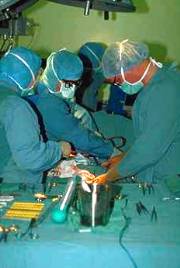Home Page
The latest articles, features and news.


All About...


Sponsored Links


Discussion Forums




Pecker Provisions


Condoms, lubes, pumps, stretchers, exercises, supplements, sports underwear and more.

Firefly Talks Dicks


Words of feminine wisdom about men's problems.

|
| | |
|

10 August 2000
Introduction To Penis Enlargement Surgery
by George Atkinson  Penis enlargement surgery (also known as penile augmentation or penile enhancement surgery) consists of two surgical procedures to enlarge the penis, one is used to increase the girth of the penis, the second is used to increase the length of the penis. Typically, patients opt to have both penis enlargement procedures carried out at the same time.
Penis enlargement surgery (also known as penile augmentation or penile enhancement surgery) consists of two surgical procedures to enlarge the penis, one is used to increase the girth of the penis, the second is used to increase the length of the penis. Typically, patients opt to have both penis enlargement procedures carried out at the same time.
Increasing the girth of the penis relies on fat cells (usually from the patients abdomen) being transplanted (injected) around the penis. The procedure, known as fat transfer, bulks-up the penis and can increase the girth of the penis by 1 to 3 inches. One of the possible drawbacks is that the transplanted fat cells feel soft, somewhat like female breast tissue. Additionally, increases in the girth of the penis achieved this way can often disappear as the fat cells are reabsorbed back into the body. Sometimes, the re-absorption of the transplanted fat is uneven and the penis is left looking lumpy and unsightly.
A variant of the fat transfer method called �dermal transfer� may overcome the fat re-absorption problem. Dermal transfer uses strips of skin and fat together. The skin stops the fat from being re-absorbed into the body but because this procedure requires strips of skin and fat to be grafted onto the penis the surgery is more complex and the risk of disfigurement is much greater.
Penis lengthening procedures are quite different from the procedures used to increase the girth of the penis. The tissue in the penis that fills with blood is called the corpora cavernosa. This spongy tissue normally extends from the penis back into the body. In some cases, half of the corpora cavernosa may be "concealed" inside the body. Penis lengthening relies on releasing this concealed tissue which has the effect of increasing the length of the penis. Releasing the concealed part of the penis is done by cutting the suspensory ligaments that keep the corpora cavernosa anchored within the body. This moves the concealed part of the penis forward achieving additional penis length outside the body. This type of penis enlargement surgery can result in substantial flaccid size gains but sometimes only a small increase in the erect penis length.
The side effects of this penis lengthening surgery stem from the fact that with the suspensory ligament no longer anchored to the pubic bone, the penis is effectively �floating loose�. If the penis is flaccid this will not cause any problems but if the penis is erect then several problems may occur. Floating loose from the pubic bone, the erect penis can slip and shift around during sex. And without the suspensory ligament to hold it, erections can point downwards. Nowadays, more sophisticated surgical techniques mean that this can be minimized but the angle of erection is still likely to be reduced no matter how the surgery is carried out.
Penis enlargement surgery has advanced a long way since the early days when penile disfigurement was almost a certainty but many surgeons still refuse to offer penis enlargement procedures because of the risks associated with it. Candidates for penis enlargement surgery should seek advice from their own doctor and ideally undergo counselling before consulting with surgeons offering these procedures.
Related:
Enlargement FAQ
Locate a phalloplasty surgeon
|
|